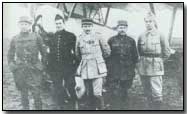Encyclopedia - Lafayette Escadrille
 From the onset of war in
Europe in August 1914 many Americans travelled to Europe and offered their
volunteer services to the Allied nations (typically Britain or France) in
the war against the Central Powers. Often this service took the form
of service in the French Foreign Legion or
in
the ambulance services (Ernest
Hemingway for one, served with the ambulance corps in France).
From the onset of war in
Europe in August 1914 many Americans travelled to Europe and offered their
volunteer services to the Allied nations (typically Britain or France) in
the war against the Central Powers. Often this service took the form
of service in the French Foreign Legion or
in
the ambulance services (Ernest
Hemingway for one, served with the ambulance corps in France).
Increasingly, American volunteers enlisted with the French Air Service from 1915 onwards (once their petition to be allowed to volunteer for military service abroad was granted by the U.S. government). It was not long before it was suggested that a squadron (or Escadrille in French) of Americans be established for active service on the Western Front.
In due course the French government sanctioned such a plan and on 20 April 1916 Escadrille Americaine - specifically N124 - was despatched to France (Luxeuil-les-Bains) for front line service. Following German protests over the naming of the squadron - the U.S. remained neutral for a further year - it was renamed Escadrille Lafayette in December 1916 (after the Frenchman who served alongside George Washington).
Initially commanded by the Frenchman Georges Thenault, N124 comprised seven American pilots - Victor Chapman, Elliot Cowdin, Bert Hall, James McConnell, Norman Prince, Kiffin Rockwell and William Thaw. Its inaugural flight mission took place on 13 May 1916 and the Escadrille's first aerial 'kill' occurred five days later, Kiffin Rockwell claiming victory over a German two-seater L.V.G.
Less happily Victor Chapman - a Harvard graduate along with Norman Prince - was the Escadrille's first fatality, killed in action a little over a month later, on 23 June 1916.
With the Escadrille's growing success (57 successes prior to February 1918) came increased worldwide fame. Consequently an increasing number of American volunteers sought service with N124. Successful applicants did not always gain entry to N124 but nevertheless passed through the Lafayette Flying Corps, a body established to assist Americans seeking service with the French Air Service. As many as 200 Americans eventually passed through the French Air Service's training programme.
Some ten months following America's formal entry into the war the Escadrille passed into American hands in February 1918. Until that date nine Americans had lost their life with the Escadrille; 38 U.S. pilots in total passed through the Escadrille.
'White Star' was a German mixture of chlorine and phosgene gas, so-named on account of the identification marking painted on the delivery shell casing.
- Did you know?
